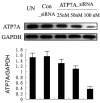Copper-transporting P-type adenosine triphosphatase (ATP7A) is associated with platinum-resistance in non-small cell lung cancer (NSCLC)
- PMID: 22304828
- PMCID: PMC3296618
- DOI: 10.1186/1479-5876-10-21
Copper-transporting P-type adenosine triphosphatase (ATP7A) is associated with platinum-resistance in non-small cell lung cancer (NSCLC)
Abstract
Background: Copper export protein ATP7A is important for maintaining copper homeostasis. Recent studies have shown that copper transporters are also involved in the transport of platinum. The goal of this study was to determine the role of ATP7A in the platinum-resistance of non-small cell lung cancer (NSCLC).
Methods: Sensitivities to platinums were detected by MTT assay and drug-resistance related genes were analyzed by real-time PCR and immunoblotting between DDP-sensitive A549 and the corresponding DDP-resistant cell subline (A549/DDP). ATP7A expression was evaluated by immunohistochemistry in tumor tissues of unresectable NSCLC patients who received cisplatin-basing chemotherapy.
Results: The expression of ATP7A was significantly higher in A549/DDP cell subline than in A549 cells at both mRNA and protein levels. The silencing of ATP7A expression in A549/DDP by siRNA partially reversed DDP-resistance (29.62%) and increased cell apoptosis. ATP7A expression was detected in 41.6%of NSCLC patients, but not in adjacent stroma nor normal lung tissues. ATP7A-positive patients had a significantly poorer histological grade (p = 0.039) and poorer response to platinum-basing chemotherapy (p = 0.001) compared with ATP7A-negative patients. Cox's proportional hazards analysis showed that ATP7A expression was an independent prognostic factor for overall survival (p = 0.045).
Conclusions: ATP7A overexpression played an important role in platinum-resistance of NSCLC, and was a negative prognostic factor of NSCLC patients treated with platinum-based chemotherapy.
Figures





Similar articles
-
miR-495 enhances the sensitivity of non-small cell lung cancer cells to platinum by modulation of copper-transporting P-type adenosine triphosphatase A (ATP7A).J Cell Biochem. 2014 Jul;115(7):1234-42. doi: 10.1002/jcb.24665. J Cell Biochem. 2014. PMID: 24038379
-
Expression of copper-transporting P-type adenosine triphosphatase (ATP7B) correlates with cisplatin resistance in human non-small cell lung cancer xenografts.Oncol Rep. 2008 Aug;20(2):265-70. Oncol Rep. 2008. PMID: 18636185
-
Predictive and prognostic value of human copper transporter 1 (hCtr1) in patients with stage III non-small-cell lung cancer receiving first-line platinum-based doublet chemotherapy.Lung Cancer. 2012 Feb;75(2):228-34. doi: 10.1016/j.lungcan.2011.06.011. Epub 2011 Jul 23. Lung Cancer. 2012. PMID: 21788094 Free PMC article.
-
The roles of copper transporters in cisplatin resistance.Cancer Metastasis Rev. 2007 Mar;26(1):71-83. doi: 10.1007/s10555-007-9045-3. Cancer Metastasis Rev. 2007. PMID: 17318448 Review.
-
MicroRNAs as Predictors of Lung-Cancer Resistance and Sensitivity to Cisplatin.Int J Mol Sci. 2022 Jul 8;23(14):7594. doi: 10.3390/ijms23147594. Int J Mol Sci. 2022. PMID: 35886942 Free PMC article. Review.
Cited by
-
Activity and Trafficking of Copper-Transporting ATPases in Tumor Development and Defense against Platinum-Based Drugs.Cells. 2019 Sep 13;8(9):1080. doi: 10.3390/cells8091080. Cells. 2019. PMID: 31540259 Free PMC article. Review.
-
Cuproptosis in cancer: biological implications and therapeutic opportunities.Cell Mol Biol Lett. 2024 Jun 25;29(1):91. doi: 10.1186/s11658-024-00608-3. Cell Mol Biol Lett. 2024. PMID: 38918694 Free PMC article. Review.
-
TAp73 regulates ATP7A: possible implications for ageing-related diseases.Aging (Albany NY). 2018 Dec 8;10(12):3745-3760. doi: 10.18632/aging.101669. Aging (Albany NY). 2018. PMID: 30530920 Free PMC article.
-
The role of copper transporter ATP7A in platinum-resistance of esophageal squamous cell cancer (ESCC).J Cancer. 2016 Oct 23;7(14):2085-2092. doi: 10.7150/jca.16117. eCollection 2016. J Cancer. 2016. PMID: 27877224 Free PMC article.
-
A cuproptosis score model and prognostic score model can evaluate clinical characteristics and immune microenvironment in NSCLC.Cancer Cell Int. 2024 Feb 10;24(1):68. doi: 10.1186/s12935-024-03267-8. Cancer Cell Int. 2024. PMID: 38341588 Free PMC article.
References
-
- Rinaldi M, Cauchi C, Gridelli C. First line chemotherapy in advanced or metastatic NSCLC. Ann Oncol. 2006;17(Suppl 5):v64–v67. - PubMed
-
- Cui Y, Konig J, Buchholz JK, Spring H, Leier I, Keppler D. Drug resistance and ATP-dependent conjugate transport mediated by the apical multidrug resistance protein, MRP2, permanently expressed in human and canine cells. Mol Pharmacol. 1999;55:929–937. - PubMed
MeSH terms
Substances
LinkOut - more resources
Full Text Sources
Medical

